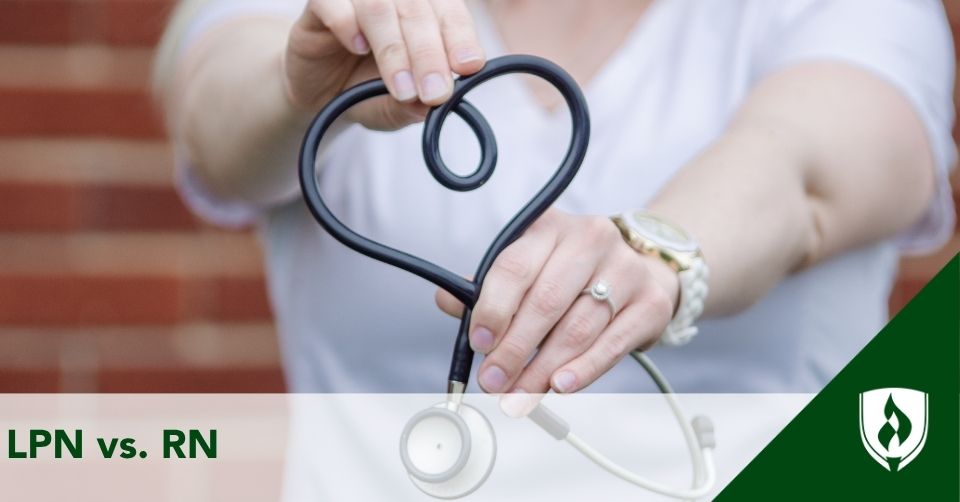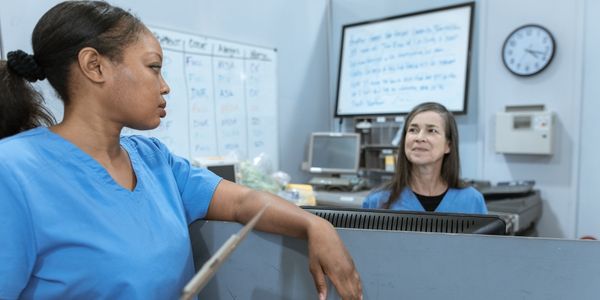LPN vs RN: Key Differences and Insights
10/23/2025

When exploring the nursing field, two of the most common pathways are Licensed Practical Nurse (LPN) and Registered Nurse (RN). While they are known to work side by side in health care settings, the day-to-day jobs, training requirements, and practices can differ significantly.
Exploring the difference between LPN and RN careers can help aspiring nurses understand how each role fits into the healthcare industry. Both licensed practical nurses (LPNs) and registered nurses (RNs) are essential in supporting patient health, ensuring patients receive safe, compassionate care, and strengthening the healthcare sector overall.
What Is a Licensed Practical Nurse (LPN)?
A Licensed Practical Nurse is trained1 to provide direct patient care under the supervision of a registered nurse or physician. LPN duties typically include2 taking vital signs, monitoring patient health, documenting care, and assisting with activities of daily living. In some states, their scope of practice also covers administering medications or carrying out patient treatment plans.
LPNs work in different health care settings2 such as hospital settings, residential care facilities, home healthcare services, and physicians’ offices. In certain states, the same role may be called a Licensed Vocational Nurse (LVN). No matter the title, licensed practical nurses (LPNs) are critical in providing basic nursing care and supporting patients and families throughout treatment.
What Is a Registered Nurse (RN)?
A Registered Nurse is a licensed healthcare professional3 who may typically provide comprehensive patient care and works independently or collaboratively with other healthcare team members. RNs typically3 assess patients, perform physical exams, and create patient care plans. They often oversee the work of LPNs, nursing assistants, and other support staff, ensuring patient safety and quality care across a variety of healthcare settings.
RNs can work in hospital settings,4 physicians’ offices, residential care facilities, home healthcare services, and community health organizations. Their scope of practice may include5 more advanced clinical responsibilities than LPNs, and in many states, RNs can specialize in areas such as pediatrics, critical care, oncology, or geriatrics. Registered nurses may choose to continue their education to pursue advanced practice roles, taking on expanded responsibilities in health care delivery and leadership.
Education Requirements for LPNs and RNs
The educational requirements for LPN and RN careers vary in length, depth, and clinical exposure.
- LPN programs typically take around one year to complete.6 These diploma programs blend classroom coursework covering medical terminology, anatomy, physiology, and physical science with supervised clinical practice in patient care. Completing a state-approved nursing program is required before taking the NCLEX-PN® exam.
- RN programs may require7 either an associate degree or a bachelor’s degree in nursing. An associate degree in nursing (ADN) generally takes two years, while a bachelor of science in nursing (BSN) may take up to four years. RN educational requirements go beyond basic care to include diagnostic tests, medical equipment use, patient care plans, and advanced nursing skills. Graduates of an approved nursing program are then eligible to take the NCLEX-RN® for RN licensure.
Both educational paths emphasize patient care, but RN programs may be appropriate for those who are looking for broader responsibilities such as implementing care plans and assessing patients.
Key Differences Between LPN and RN
The primary distinction in the LPN vs RN comparison lies in the scope of practice, level of training, and the responsibilities nurses are qualified to carry out.
- Education and training: LPN programs6 are typically shorter diploma programs (one year or more), while RN programs7 can take 2-4 years depending on whether a student pursues an associate or a bachelor’s degree. As a result, RNs may complete more coursework in areas like pharmacology, patient care plans, diagnostic tests, and leadership in health care settings.
- Licensing requirements: Both nursing roles require8 passing a National Council Licensure Examination. LPNs must pass the NCLEX-PN®, while RNs must complete the NCLEX-RN®. These exams test different levels of nursing knowledge and clinical decision-making skills.
- Scope of practice: LPNs provide2 basic patient care such as taking vital signs, administering medications, recording observations, and supporting patients with daily needs. RNs, on the other hand, are trained5 to assess patients, create and implement care plans, and make independent nursing judgments. In most states, RNs also delegate tasks to LPNs and nursing assistants.
- Autonomy in patient care: RNs have a broader8 scope of practice and more decision-making authority. They may manage complex patient cases, operate advanced medical equipment, and collaborate closely with physicians on patient treatment plans. LPNs often work8 under the supervision of RNs or physicians.
- Specialization options: While LPNs play a vital role in providing general nursing care, RNs have more opportunities to specialize8 in fields like pediatrics, critical care, oncology, or geriatrics. RNs can also pursue advanced practice roles such as nurse practitioner or nurse anesthetist with further education.
- Work environments: Both LPNs and RNs are needed in hospital settings, residential care facilities, physicians’ offices, and home healthcare services. However, RNs are more likely to work4 in acute care or specialized hospital units where advanced nursing skills are essential, while LPNs are more commonly employed9 in long-term care or outpatient facilities.
- Supervisory responsibilities: RNs may8 supervise LPNs, nursing assistants, and other members of the healthcare team. LPNs, while critical in direct patient care, generally do not hold supervisory roles.
Together, LPNs and RNs form the backbone of the nursing profession. Their complementary roles allow them to deliver high-quality, patient-centered care across a variety of health care environments.
Student Pathways at Rasmussen University
Rasmussen University offers nursing programs designed for students at every stage of their education, whether you’re just starting out or expanding your skills as a licensed nurse.
- Practical Nursing Diploma (PN/LPN): Available online and on campus, this LPN program10 includes hands-on field experience and may prepare students to sit for the NCLEX-PN® exam. It focuses on foundational nursing skills such as monitoring vital signs, providing basic patient care, and supporting patient health.
- Professional Nursing Associate’s Degree (ADN/RN): Offered online and on campus with field experience, this ADN/RN program11 may prepare students to sit for the NCLEX-RN® exam and provides comprehensive training in patient care plans, medical equipment use, and advanced nursing skills.
- Bachelor of Science in Nursing (BSN): Available online and on campus with clinical field experience, the BSN program12 equips students with leadership skills, evidence-based practice knowledge, and preparation for diverse healthcare settings.
- RN to BSN: For licensed RNs, this online RN to BSN program13 builds on prior education and experience, expanding skills in leadership, patient care, and health care technology, with field experience included to apply learning in real-world settings.
Rasmussen supports students with flexible learning options, hands-on clinical opportunities, and guidance throughout their nursing education, may help them take the next step toward their nursing career.
LPN vs RN: Career Paths
LPN and RN careers both offer opportunities for career advancement and specialized training.
Aspiring LPNs can later enroll in bridge programs to continue their education and transition into RN roles. Some pursue an associate degree,11 while others move directly into a BSN bridge program.
Registered nurses may choose to specialize in specific areas or further study can also lead to advanced practice roles.
Professional certifications14 in specialized patient populations such as gerontology or wound care allow both LPNs and RNs to expand their nursing skills and support diverse health care needs.
Job Outlook and Growth Prospects: LPN vs RN
The Bureau of Labor Statistics indicate a positive job outlook for both LPNs and RNs, with steady growth expected in the coming decade.
- Registered Nurses (RNs): Employment of registered nurses is projected to grow15 5% from 2024 to 2034, faster than the average for all occupations. The project job growth for registered nurses reflects the ongoing need for nursing care in hospital settings, home health care services, and residential care facilities, as well as the demand for specialized roles in advanced nursing practice.
- Licensed Practical and Licensed Vocational Nurses (LPNs/LVNs): Employment of licensed practical and licensed vocational nurses is projected to grow16 3% from 2024 to 2034, about as fast as the average for all occupations. Opportunities will remain especially strong in long-term care and outpatient health care settings where basic nursing care and patient support are essential.
Choosing Your Path: LPN vs RN
When comparing LPN vs RN, the decision often comes down to the level of responsibility, scope of practice, and education requirements each student is prepared to pursue. Both licensed practical nurses and registered nurses are integral to the nursing profession, ensuring patients receive quality health care across a wide range of healthcare settings.
Whether you’re exploring diploma programs, an associate degree, or a BSN degree, understanding the difference between LPN and RN careers can help you take the next step toward your nursing career.
If you’re ready to take the next step toward a hands-on nursing career, explore “How to Become an LPN” to see what education and credentials are typically needed.
NCLEX-PN® is a registered trademark of The National Council of State Boards of Nursing, Inc. 111 East Wacker Drive Suite 2900 Chicago, ILLINOIS UNITED STATES 60601
NCLEX-RN® is a registered trademark of National Council of State Boards of Nursing, Inc. 111 East Wacker Drive Suite 2900 Chicago, ILLINOIS UNITED STATES 60601
1American Nurses Association, "How to Become a Licensed Practical Nurse," https://www.nursingworld.org/content-hub/resources/becoming-a-nurse/how-to-become-a-licensed-practical-nurse/ (accessed September 30, 2025).
2Bureau of Labor Statistics, U.S. Department of Labor, Occupational Outlook Handbook, Licensed Practical and Licensed Vocational Nurses, at https://www.bls.gov/ooh/healthcare/licensed-practical-and-licensed-vocational-nurses.htm#tab-2 (visited September 30, 2025).
3American Nurses Association, "What is Nursing?" https://www.nursingworld.org/practice-policy/workforce/what-is-nursing/ (accessed September 30, 2025).
4Bureau of Labor Statistics, U.S. Department of Labor, Occupational Outlook Handbook, Registered Nurses, at https://www.bls.gov/ooh/healthcare/registered-nurses.htm#tab-3& (visited September 30, 2025).
5Bureau of Labor Statistics, U.S. Department of Labor, Occupational Outlook Handbook, Registered Nurses, at https://www.bls.gov/ooh/healthcare/registered-nurses.htm#tab-2 (visited September 30, 2025).
6Bureau of Labor Statistics, U.S. Department of Labor, Occupational Outlook Handbook, Licensed Practical and Licensed Vocational Nurses, at https://www.bls.gov/ooh/healthcare/licensed-practical-and-licensed-vocational-nurses.htm#tab-4 (visited September 30, 2025).
7Bureau of Labor Statistics, U.S. Department of Labor, Occupational Outlook Handbook, Registered Nurses, at https://www.bls.gov/ooh/healthcare/registered-nurses.htm#tab-4 (visited September 30, 2025).
8American Nurses Association, "Types of Nurses and What They Do," https://www.nursingworld.org/content-hub/resources/nursing-resources/types-of-nurses-and-what-they-do/ (accessed September 30, 2025).
9Bureau of Labor Statistics, U.S. Department of Labor, Occupational Outlook Handbook, Licensed Practical and Licensed Vocational Nurses, at https://www.bls.gov/ooh/healthcare/licensed-practical-and-licensed-vocational-nurses.htm#tab-3 (visited September 30, 2025).
10Rasmussen University, "Practical Nursing (PN/LPN) Degree Overview," https://www.rasmussen.edu/degrees/nursing/practical-nursing/ (accessed September 30, 2025).
11Rasmussen University, "Professional Nursing (ADN/RN) Degree Overview," https://www.rasmussen.edu/degrees/nursing/professional-nursing/ (accessed September 30, 2025).
12Rasmussen University, "Bachelor of Science in Nursing (BSN) Degree Overview," https://www.rasmussen.edu/degrees/nursing/bachelor-science-nursing-bsn/ (accessed September 30, 2025).
13Rasmussen University, "RN to BSN Program Overview," https://www.rasmussen.edu/degrees/nursing/rn-bsn/ (accessed September 30, 2025).
14American Nurses Association, "Certification Review," https://www.nursingworld.org/continuing-education/ce-subcategories/certification-review/ (accessed September 30, 2025).
15Bureau of Labor Statistics, U.S. Department of Labor, Occupational Outlook Handbook, Registered Nurses, at https://www.bls.gov/ooh/healthcare/registered-nurses.htm#tab-6 (visited September 30, 2025).
16Bureau of Labor Statistics, U.S. Department of Labor, Occupational Outlook Handbook, Licensed Practical and Licensed Vocational Nurses, at https://www.bls.gov/ooh/healthcare/licensed-practical-and-licensed-vocational-nurses.htm#tab-6 (visited September 30, 2025).



